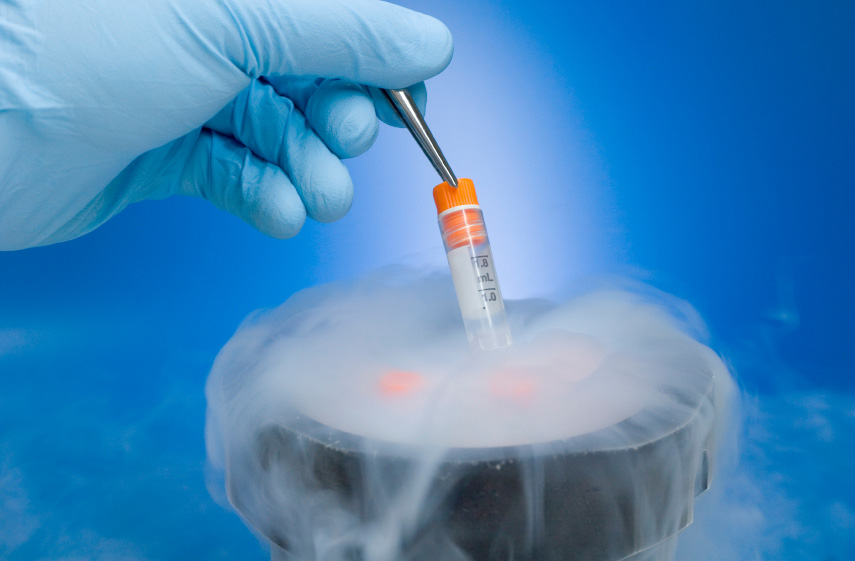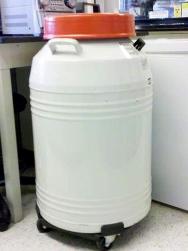



It is possible to cryopreserve sperm and embryo at -196º C in liquid N2 by computerized slow cooling method. Subsequent cryothaw cycles treatment becomes cost effective and patient does not require undergoing active cycle management. Embryos and sperms can be kept cryopreserved for years. Slow cooling cryopreservation needs computerized cryo machine. Recently developed vitrification technique uses rapid cooling of embryo. Human egg cryopreservation was difficult because of damage done to spindles. With successful cryopreservation of ovarian tissue it is of immense help to young cancer patients undergoing chemotherapy or ionizing radiation therapy for future fertility.
Egg retrieval under ultrasound guidance and subsequent fertilization and embryo culture are carried out according to our current procedures. If there happens to be a surplus of embryos following selection for fresh transfer (usually between one to four embryos are transferred to the uterus), then embryos of sufficient quality may be considered for cryostorage. While embryos can be frozen at any preimplantation stage between one-cell (one day old) to the blastocyst stage (5-6 days old). In certain cases where all embryos need to be frozen without a fresh transfer (e.g., when a woman may be at risk from ovarian hyperstimulation that might be complicated by pregnancy), we generally freeze all embryos the day after egg collection at the one-cell stage.
Techniques of controlled-rate freezing are utilized that slowly cool embryos in cryoprotectant fluid (“anti-freeze” solution) from body temperature down to -196°C, at which temperature they are stored in containers of liquid nitrogen called dewars. The embryos are actually contained within special indelibly labeled plastic vials, or straws, that are sealed prior to freezing. Once frozen, they are placed inside labeled tubes attached to aluminum cans and stored in numbered canisters within the liquid nitrogen dewar. Site and label designations are stored in three separate file systems to avoid confusion and misidentification of cryopreserved embryos. When it comes time to thaw the embryos, all available identifiers of the stored specimen must match and be confirmed before thawing commences. The embryos are thawed out at room temperature, which takes about one to two minutes. However, the most critical element of the thaw procedure is not the timing but the careful dilution of the cryoprotectant fluid to return the embryo to its favored culture medium. This permits resumed growth and development in vitro. Once this is done, the embryo is assessed for cryodamage to determine if it is suitable for transfer. Experience has shown that if the embryo survives 50% or more intact, it is worthwhile to replace it. Embryos can accommodate such levels of cellular damage and still establish healthy pregnancies.
Varying strategies may be applied according to how many and which embryos are thawed prior to transfer. It should be noted that not every couple undergoing IVF will need to worry about embryo freezing/thawing, since not every couple will have sufficiently large number of “surplus” or non-transferred embryos available for freezing. In the event that there are more than two or three embryos frozen, thawing is usually undertaken until two to three healthy appearing embryos are recovered. In some cases, this may mean that all the cryopreserved embryos are thawed, in others just two or three. There always remains a possibility that there may be no embryo survival after thaw occurs, and no transfer is possible. If many early embryos are frozen, it is possible to thaw all of them and culture them for several days to allow selection of the best for transfer. When too many embryos are available for transfer in this circumstance, then extra embryos of sufficient quality may be refrozen for later use. This course of action has produced healthy offspring, proving the efficacy of double freezing of embryos.
During a medication-prepared frozen/thawed embryo transfer cycle as a patient, you will follow a treatment schedule using Lupron, estrogen (pills) and progesterone (suppository) in order to achieve appropriate endometrium (uterine wall lining) for embryo transfer. Following embryo transfer, estrogen and progesterone will be administered daily until the 7th to 8th week of pregnancy or until a negative pregnancy test.
The Ethics Committee of the American Society of Reproductive Medicine (ASRM) has published guidelines for ethical consideration of human embryo cryopreservation. Possible advantages of cryopreservation of embryos suggested by the Committee include
The primary concern with the use of cryopreservation techniques is the possible loss of embryos to cryoinjury, but it is very likely that freezing will cause loss of some embryos, perhaps as many as 25-50% of those cryostored. One interpretation of this is that cryopreservation may even act as a “selection gate” for the more viable embryos, though this has never been proven.
Another concern with cryopreservation is the potential risk of birth defects in children produced from frozen/thawed embryos. In the domestic animal industry, large-scale freezing and transfer of embryos has not resulted in increased birth defects. Studies to date on those human offspring arising from thawed embryos have not shown any significant increase in abnormalities when compared to pregnancy outcomes in the rest of the population.
cryopeservation of semen only for the pateint who are under going ivf treatment,but we are not doing semen banking.
When a specimen is processed for cryopreservation: